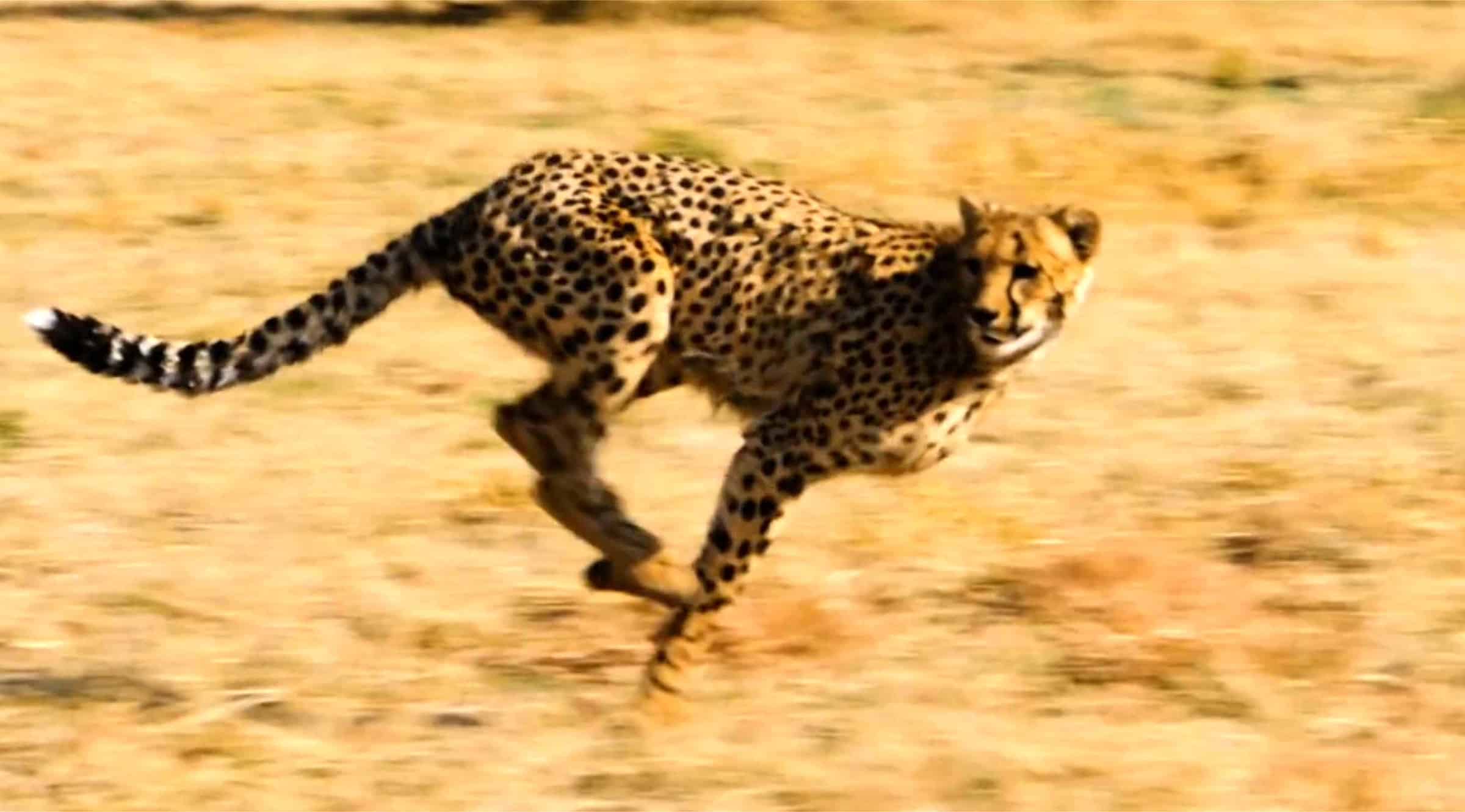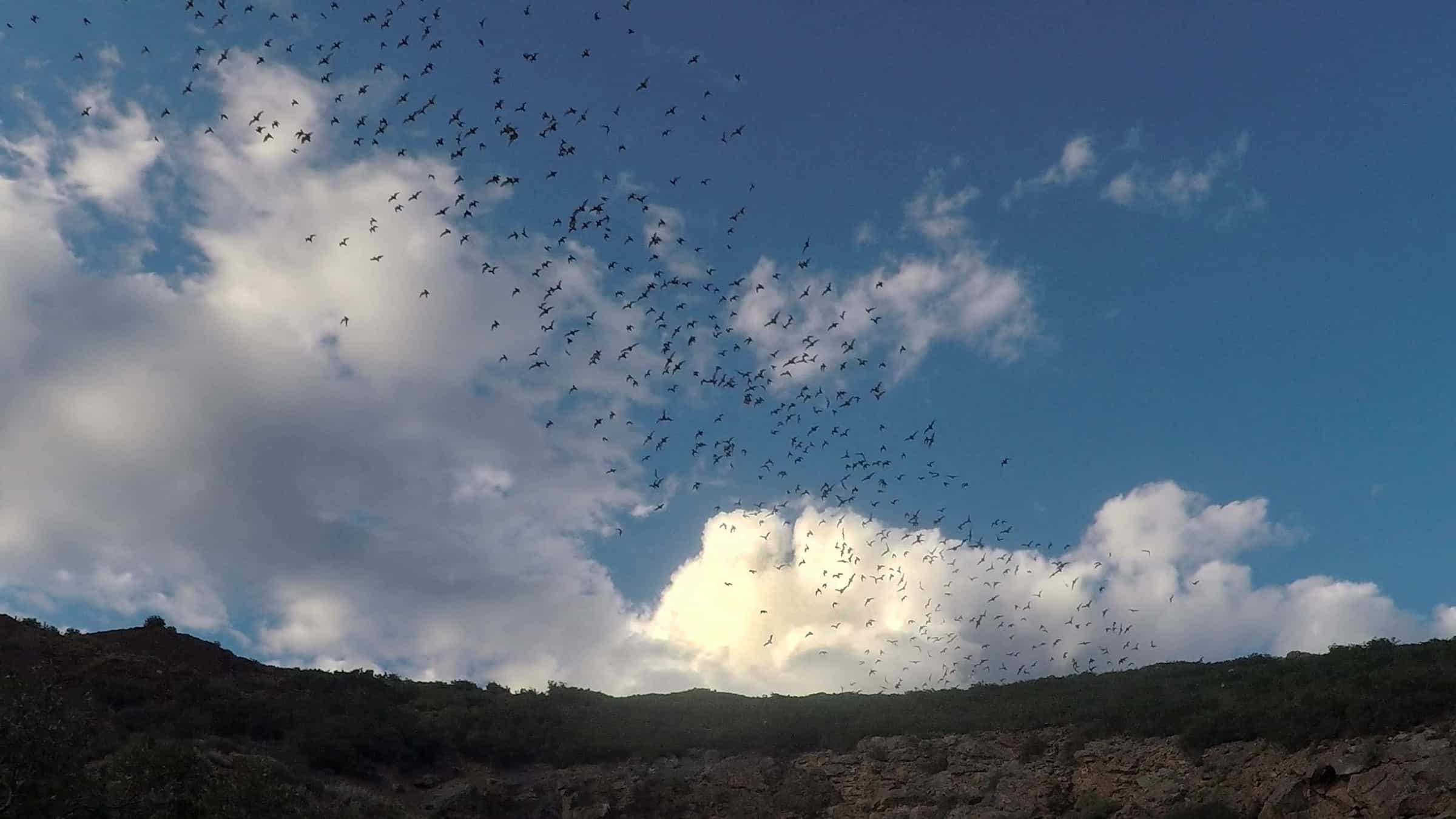 Evolution
Evolution
 Intelligent Design
Intelligent Design
Hippos, Cheetahs, Bats: Mammals Master Physics

Whether sleek, lumbering, or aerobatic, mammals are well equipped with the know-how to push their movements to the limits of the possible.
From high school physics, we learned that the kinetic energy needed for movement is a function of mass and velocity: (K = 1/2 mv2), and that mass is proportional to density and volume (M = Vd). Additionally, the mass of a body grows by the cube as the surface area grows by the square, so that as an animal grows from baby to adult, it will require more energy from its muscles to move at the same speed (think of a newly hatched Ultrasaurus growing up to be a towering adult). These laws of physics determine how much energy must be produced by muscles to move an animal during its life and how strong its bones must be to withstand the stresses of movement. There are also limits to how quickly neurons can signal the muscles to contract; a giraffe’s brain has a longer distance to traverse when signaling its feet compared to the corresponding path length in a mouse.
Today let’s investigate new findings about three mammals — one large, one medium, and one tiny — that show mastery of the physics needed to perform extraordinary feats.
Hopping Hippos
The humor in one of Disney’s original Fantasia segments stems from the incongruity of imagining fat hippopotamuses dancing daintily on their tiptoes and leaping into the air. Something not quite so fanciful happens in the real world. Two scientists from the University of London’s Royal Veterinary College took high-speed videos of running hippos and found that there are brief moments when all four feet of these massive animals are off the ground. The paper by Hutchinson and Pringle in PeerJ calls this a “apparently a new discovery” about these large land mammals after they analyzed 169 strides from 32 hippos with high-speed cameras.
Considering that a male hippopotamus can weigh up to 1,500 kilograms (3,300 pounds), the energy requirements for such a feat are considerable. Africans fear hippos because they kill more people annually than do lions. If provoked, they can charge out of the water and give chase at 30 km/h (19 mph), more than twice the speed of most humans. Summarizing the findings, Bob Yirka wrote in Phys.org,
They also found that when they run at top speed, they lift all four of their feet off the ground at the same time at certain points in their gait — this happens 15% of the time while running. Each occurrence lasted for approximately 0.3 seconds. Further study showed that the hippos run using a trotting type gait rather than a gallop, which is the way rhinos run. [Emphasis added.]
If you want to be astonished, look at Figure 5 in the open-access paper and see a snapshot of an airborne hippopotamus!
Charging Cheetahs
Known to be the fastest land mammals, cheetahs rightly win our admiration. I learned from guides on an African safari last year that their high-speed runs tend to be in short sprints. They sneak up on their prey and only charge when close enough for a likely catch. But why aren’t more mammals capable of speeds of 60 mph like cheetahs?
The answer, according to a new study from Imperial College London, is that cheetahs occupy a “sweet spot” within the range of body sizes.
There’s a discrepancy in the animal kingdom. While many key traits such as strength, limb length, lifespan and brain size tend to increase with animals’ size, maximum running speeds tend to be greatest in medium-sized animals.
Dr. David Labonte from the Department of Bioengineering added, “The fastest animals are neither large elephants nor tiny ants, but intermediately sized, like cheetahs.” Why is that?
There are two limits to speed in animals, the paper in Nature Communications explains: the “kinetic energy capacity” which dominates in small animals, and the “work capacity” which dominates in large animals. Work capacity, though, is limited by how far a muscle can contract. Whichever limit is reached first determines the speed limit. Intermediate-size cheetahs are in a “sweet spot” permitting their impressive speeds. (This does not mean that all mammals their size will be fast runners. Much more design is required.)
The team modeled the limits of 400 animals from ants to dinosaurs with masses ranging over 11 orders of magnitude. According to the model, a 40-ton sauropod would hardly be able to move. Without observing them in person, scientists can only speculate that they had special adaptations. I am intrigued by small lizards in my hometown that can run several body lengths per second. Their short body lengths compared to a cheetah, though, do not permit them to cover as much ground, even though their little legs look like a blur, they move so fast.
Incidentally, a study from the University of Michigan reports the surprising discovery that the speed of a muscle contraction depends on a familiar substance: water. Water in a muscle fiber helps it act as a “self-squeezing active sponge,” two physicists say. Fluid flow in muscle fibers gives them “odd elasticity” allowing three dimensional deformations. “The researchers envision each muscle fiber as a self-squeezing active sponge, a water-filled, sponge-like material that can contract and squeeze itself through the action of molecular motors,” one of the physicists explained.
The finite time it takes for the water to move in the muscle fiber sets an upper limit on how fast a muscle can twitch. That limit is high, though. A rattlesnake can move its rattle hundreds of times a second. Flying insects can beat their wings up to a thousand times a second! A mosquito’s wing beat appears to be close to the theoretical limit. But we’re focusing on mammals here, and there are other feats of physics in Mammalia. Here’s another.
Boisterous Bats
Several new research papers investigated bats’ air-show-worthy stunts in the air. One feat is the ability to land upside down on a cave roof in the dark. A paper in iScience tries to explain how this evolved, but it requires heavy doses of imagination:
In bats, a group for which the specific origins of flight remain unresolved, the evolutionary history of landing mechanics provides a perspective that complements that of the evolution of powered flight itself. Despite a lack of fossils, most available data point to a gliding origin of bat flight in which the hypothetical bat ancestor was arboreal, possessed gliding membranes made of skin and performed locomotion similar to that of extant gliding mammals.
Enough of that evidence-free speculation. Observers should be astonished not only that bats can perform this trick, but that they do it in very crowded conditions in the dark, and simultaneously are able to locate kin by their calls in the cacophony of clicks.

Speaking of clicks, bats face an enormous challenge trying to pick out their own echoes when hunting in colonies of hundreds of thousands of other clickers. New Scientist tells about a clever method of data collection to try to figure out how bats solve the “cocktail party problem” which we all recognize when trying to hear a familiar voice in a crowd. Laura Kloepper from the University of New Hampshire trained a hawk to fly through a swarm of 600,000 bats in New Mexico so that she could record the soundscape from a backpack recorder attached to the bird. She acquired recordings from 23 passes through the swarm and analyzed them with a computer.
From these recordings, the researchers extracted characteristics of each bat’s “voice”. They teased out extremely small differences from one individual’s call to the next and found that these tiny variations can drive enormous differences in the signal that returns to a bat. This makes it easier for each bat to compare a returning echo to the one it sent out and ignore the input that doesn’t match. “Really subtle changes have a big impact on whether a bat accepts or rejects the return signal,” says Kloepper.
On a similar note, Pederson et al. writing in Current Biology investigated the “superfast” ability of free-flying bats to adjust their calls in the presence of noise. This is the “Lombard response” we all know from raising our voice or changing pitch in noisy situations to be heard. The researchers found that “Bats call louder in response to sudden onsets of noise in just 20 ms.”
We found that the bats invoked a bandwidth-dependent Lombard response of 0.1–0.2 dB per dB increase in noise, with very short delay and relapse times of 20 ms in response to onsets and termination of duty-cycled noise.In concert with the absence call time-locking to noise-free periods, these results show that free-flying bats exhibit a superfast, but hard-wired, vocal-motor response to increased noise levels. We posit that this reflex is mediated by simple closed-loop audio-motor feedback circuits that operate independently of wingbeat and respiration cycles to allow for rapid adjustments to the highly dynamic auditory scenes encountered by these small predators.
That’s quite a feat to do this in the dark while hunting. Another paper in Current Biology by Nishiumi et al. adds to the complexity involved. While hunting, bats employ “three echolocation tactics and a flight tactic for tracking” that improves accuracy. Echolocation is intrinsically difficult while flying because of built-in delays before echoes are received and processed. In the meantime, the bat must keep maneuvering its flight path to stay on target. Think of fighter jets:
The ability of “target tracking,” such as keeping a target object in sight, is crucial for various activities. However, most sensing systems experience a certain degree of delay due to information processing, which challenges accurate target tracking. The long history of studies on animal behavior has revealed several tactics for it, although a systematic understanding of how individual tactics are combined into a strategy has not been reached. This study demonstrates a multifaceted tracking strategy in animals, which mitigates the adverse delay effects with small implementation costs.
The team’s experiments with an active-sensing bat showed that the animal combined multiple strategies to “reduce the burden of multitasking management.” Three strategies involved sending and receiving the signal.
Simultaneously, the flight tactic, the counter maneuver, assists echolocation by stabilizing the target direction. Our simulation results demonstrate that these combined tactics improve tracking accuracy over a wide range of delay constraints.… Our findings reveal the sophisticated strategy in animals’ tracking systems and provide insights into understanding and developing efficiently integrated strategies in target tracking across various disciplines.
Bonus Mammal
For fun, here’s one more clever mammal. We’ve all seen nature films showing foxes that leap high and dive nose-first into the snow to catch a mouse. How can they do this without getting injured? Canid skulls don’t come with shock absorbers. This “mousing” behavior, say Yuk et al. in PNAS, is possible because of specialized skull adaptations:
Our research highlights the significance of skull morphology, specifically the curvature of the snout, in mitigating the impact forces endured by foxes during snow diving. Our findings show that the initial impact phase of fox snow diving closely resembles the behavior of fluids at high Reynolds numbers. This insight sheds light on the biomechanics of these unique hunting behaviors, offering valuable contributions to our understanding of animal adaptations and their interactions with their environment.
A high Reynolds number indicates turbulent flow, where inertial forces dominate viscous forces. That little upward curve on the fox’s narrow snout lets it plunge into the snow and dissipate the energy into the surroundings. How did the fox learn to adapt its skull and snout that way? Without the ability to hear the mouse under the snow, and the instinct to leap and dive into it, a curved snout would do little good.
In summary, animals (in this case, mammals) are born well equipped to push the laws of physics to the limit. It’s much more satisfying to focus on observational science than Darwinian storytelling. Learning and understanding how things work has the added benefit of inspiring engineers to imitate the design strategies all around us.
